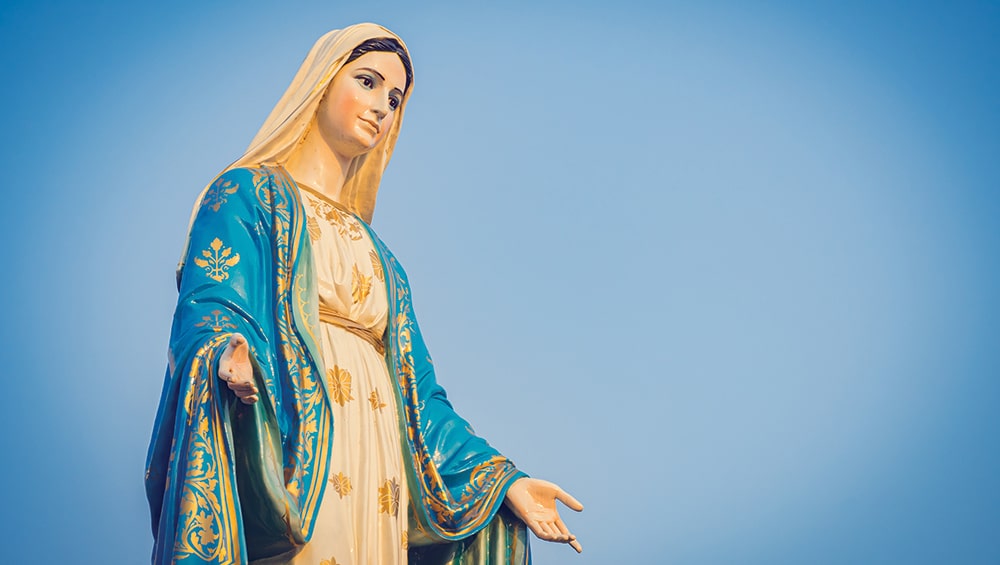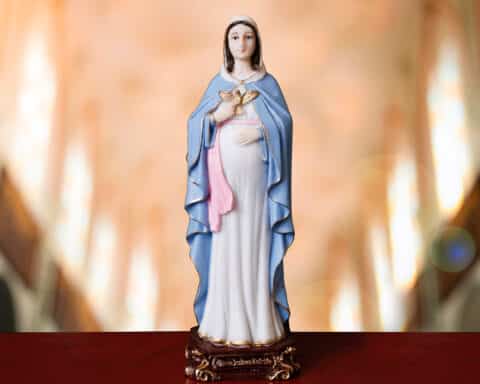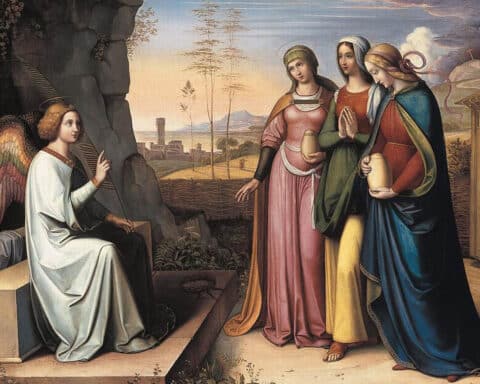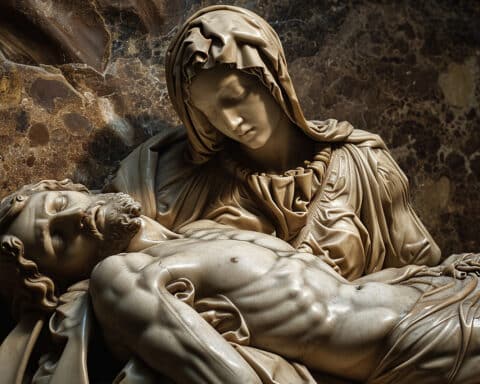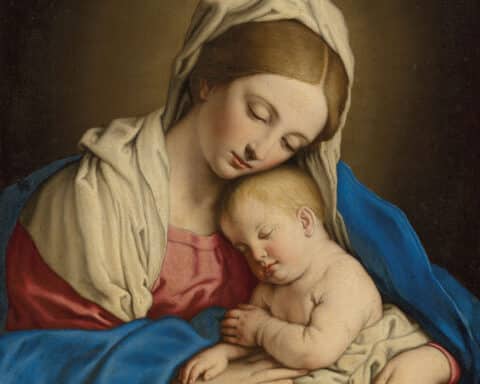Just as the Catholic Church has turned to the Blessed Virgin Mary numerous times in history, so, too, has the tragedy of the worldwide coronavirus pandemic moved many Catholics to pray to Our Lady for help. Perhaps the most vivid example has been Pope Francis. On March 15, the Holy Father made a mini-pilgrimage to the Basilica of St. Mary Major in Rome to pray before the icon of Maria Salus Populi Romani (Mary, Salvation/Health of the Roman People) housed in the Pauline Chapel of the Basilica. Weeks later, he had the icon brought to St. Peter’s Basilica for his March 27 extraordinary urbi et orbi blessing (“to the city and the world”). The Marian icon was also present for the liturgies of the Holy Triduum.
Following the pope’s example, numerous leaders of the Faith around the world have entrusted their nations to Our Lady, including the U.S., whose bishops were to reconsecrate the country on May 1.
The witness of the pope and Church leaders is clear: Mary is both the Mother of the Church and the Mother of all people. But why should we turn to Mary in times of need, and how has she interceded for the Church throughout history?
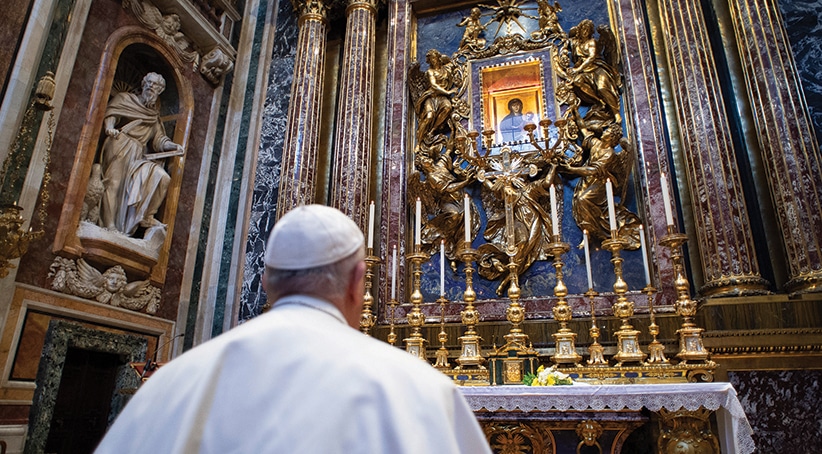
Advocate and spiritual mother
From a Catholic perspective, the intercessory power of the Virgin Mary has biblical and patristic roots. Early Church Fathers such as St. Justin Martyr (A.D. 100-65) and St. Irenaeus (130-202) recognized Mary as the “New Eve” (cf. Gn 3:15) who became the advocate of Eve. St. Ephrem the Syrian (306-73) spoke of Mary as “the advocate of the abandoned,” and Theoteknos of Livias (550-650) referred to Mary “the advocate of the human race.”
At the wedding feast of Cana (cf. Jn 2:1-12), Mary showed her intercessory power and her concern for those in need. In his 1987 encyclical Redemptoris Mater, St. John Paul II described Mary’s intercession at Cana as an expression of her maternal mediation:
“At Cana in Galilee there is shown only one concrete aspect of human need, apparently a small one of little importance (‘They have no wine’). But it has a symbolic value: this coming to the aid of human needs means, at the same time, bringing those needs within the radius of Christ’s messianic mission and salvific power. Thus there is mediation: Mary places herself between her Son and mankind in the reality of their wants, needs and sufferings. She puts herself ‘in the middle,’ that is to say she acts as a mediatrix not as an outsider, but in her position as mother” (No. 21).
Mary’s intercessory power is found in her role as Queen Mother prefigured in the First Book of Kings. When Bathsheba, King Solomon’s mother, makes a request, the king says to her, “Ask it, my mother, for I will not refuse you” (1 Kgs 2:20). The New Testament also presents Mary as the Mother of all the beloved disciples of her son as represented by John the Apostle standing under the cross (cf. Jn 19:26-27). More recently, the Second Vatican Council explained that Mary is a spiritual mother who, taken up to heaven, continues with maternal charity to care “for the brethren of her son, who still journey on earth surrounded by dangers and difficulties” (Lumen gentium, No. 62).
Appeals to the Virgin Mary throughout Church history
Throughout Church history, Catholics have turned to the Blessed Virgin Mary in times of need. The icon of Mary, Salus Populi Romani, brought by Pope Francis to St. Peter’s Basilica for the March 27 prayer service and the Easter Triduum, has a long tradition of turning to the Blessed Mother in times of special need. According to one legend, the icon was painted by St. Luke the Evangelist and then discovered by St. Helena in Jerusalem in the fourth century. Sixthteenth century Church historian Cardinal Cesare Baronius believed the icon was of Byzantine origin, and it was brought to Rome during the pontificate of Pope St. Gregory the Great, who was the Roman pontiff from 590 to 604. When a terrible plague broke out, Pope Gregory carried the icon around Rome in a solemn procession invoking the Madonna’s intercession. The plague ceased, and the icon was placed in the Basilica of St. Mary Major.
Other popes have also prayed before the Marian icon in times of need. During the pontificate of Pope St. Pius V (1566-72) another plague broke out in Rome. Pius V carried the icon to St. Peter’s Basilica and prayed to Our Lady to help stop the plague, which soon ended thanks to her intercession. Pius V also prayed before the icon to ask for Our Lady’s help in the Battle of Lepanto against the Turkish fleet in 1571. In addition, he initiated a wide-scale Rosary crusade before the battle, and he even placed a replica of the image of Our Lady of Guadalupe in the flagship of the Catholic fleet under Duke Don John of Austria. The outnumbered Catholic fleet, aided by a sudden wind shift, was victorious in the battle on Oct. 7, 1571. To show his gratitude to the Blessed Mother, Pius V, established the Feast of Our Lady of Victory for Oct. 7, which eventually was renamed Our Lady of the Rosary.
When cholera broke out in Rome in 1837, Pope Gregory XVI prayed before the icon of Salus Populi Romani, and the epidemic ended. In thanksgiving to Our Lady, Gregory XVI issued a papal bull entitled Caelestis Regina, announcing the coronation of the icon on August 15, 1838, the Feast of the Assumption.
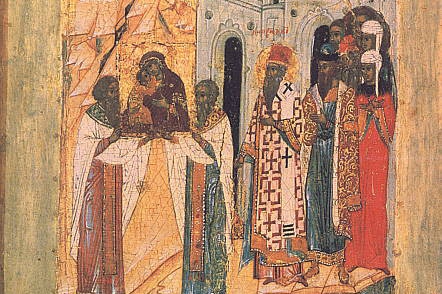
Throughout the Middle Ages and into modern times, various Catholic leaders have asked for Our Lady’s intercession in times of battle. Before the Aug. 14, 1385, Battle of Aljubarrota in Portugal, the future King John I made a vow to the Virgin Mary that he would build a monastery in her honor if the Portuguese army was victorious against the invading Spanish. After the Portuguese won, King John I kept his promise, and the monastery, which was entrusted to the Dominican order, remains a place of pilgrimage in Portugal not far from Fatima.
When the Turco-Mongol conqueror, Tamerlane, invaded Moscow in 1395, Prince Vasili asked that the icon of Our Lady of Vladimir be brought to Moscow. After having a terrifying dream of Our Lady leading an army to protect Moscow, Tamerlane retreated. When Poland was invaded by the Teutonic Knights, the armies of Lithuania and Poland sang the hymn, “Bogurodzica Dziewica” — God’s Virgin Mother — and defeated the Prussians in the battle of Grunwald-Tannenberg, which took place on July 15, 1410, the feast of St. Vladimir.
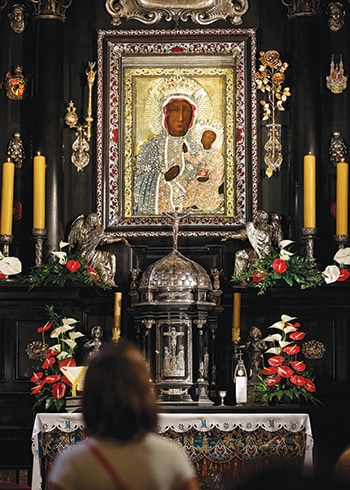
Our Lady of Czestochowa is another Marian devotion that has been called upon in distress. In 1655 when Sweden invaded Poland, the monks of Trinity Monastery prayed to Our Lady of Czestochowa, and the Swedes were driven from Poland. After this victory, the Polish King, Jan Kazimierz II, proclaimed Mary the Queen of Poland. Soon after, in 1683, the Turkish troops invaded Vienna in an attempt to take over Europe. The Polish King Jan III Sobieski came to the rescue of the Austrian and Hungarian troops but not before stopping at Czestochowa to pray before the icon of Our Lady. In thanksgiving for this victory, Bl. Innocent XI adopted the local Spanish feast of the Holy Name of Mary and extended it to the General Roman Calendar.
Consecrations to Mary in times of distress
Throughout Church history, popes have formally consecrated the world and nations to the Blessed Mother during other times of great distress.
In 1917, Europe was in the midst of World War I, and it seemed that death, violence and anarchy reigned. On May 5, 1917, Benedict XV issued a letter appealing to both Jesus and the Virgin Mary to intervene to stop the war. In this letter, he pleaded for an end to the vast conflict described as “the suicide of civilized Europe.” The Holy Father stated that because “all the graces which the author of every good thing deigns to bestow on the poor children of Adam are, by the loving counsel of his Divine Providence, distributed through the hands of the Most Holy Virgin, we desire that the earnest and confident appeal of her afflicted children may more than ever be addressed in this dreadful hour to the great Mother of God.” Benedict XV, therefore, asked that the invocation, “Queen of Peace, pray for us,” be added to the Litany of Loreto “so that to Mary, who is the Mother of mercy and omnipotent by grace (Madre di misericordia ed onnipotente per grazia)” may be moved “by the agonizing cries of mothers and wives, the wailing of innocent children, and the sighs of all hearts … to obtain for the stricken world the peace that is asked.” Eight days after this heartfelt appeal for peace, the Virgin Mary appeared to three shepherd children at Fatima in the “Cova da Iria,” the cove or cradle of peace. She told the children that the war would end, but a worse war would ensue if people did not convert.

As is known, another horrible conflict, Word War II, broke out, and the world was in turmoil once again. On Oct. 31, 1942, in the midst of the war, Pope Pius XII consecrated the world to the Immaculate Heart of Mary. After the war ended, the errors of Russia — warned about by Our Lady of Fatima — resulted in the Cold War and the spread of atheistic communism.
On May 13, 1981, an assassin’s bullet narrowly missed striking a lethal blow to Pope John Paul II. The Holy Father attributed the saving of his life to the intervention of Our Lady of Fatima whose first apparition to the shepherd children occurred on that day 1917. The following May, John Paul II traveled to Fatima to thank Our Lady for saving his life, and then on March 25, 1984, John Paul II carried out the wish of Our Lady of Fatima to consecrate Russia to the Immaculate Heart of Mary in communion with the Catholic bishops of the world. After this consecration, the Solidarity Movement in Poland gained momentum, and a series of changes in the Soviet Union began to occur. On Nov. 9, 1989, the Berlin Wall came down, and the next month President Mikhail Gorbachev of the Soviet Union traveled to the Vatican to meet with Pope John Paul II to begin a series of steps signaling the end to the Communist persecution of religion in Russia.
Prayers of appeal to Our Lady
One of the earliest known prayers to Mary is the Sub tuum praesidium from the third or fourth century. This prayer reads: “We fly to thy protection, O Holy Mother of God. Do not despise our petitions in our necessities, but deliver us always from all dangers, O Glorious and Blessed Virgin.” This prayer manifests confidence in Mary’s power to deliver us from all danger. On Sept. 29, 2018, Pope Francis asked Catholics to recite this prayer along with the prayer to St. Michael the Archangel after every Rosary during the month of October to help protect the Church against the devil.
The Catechism of the Catholic Church cites the ancient saying of Prosper of Aquitaine from the fifth century that the law of praying establishes the law of believing (legem credendi lex statuat supplicandi), which is usually simplified to read: lex orandi, lex credendi — the law of praying is the law of believing (No. 1124). This principle helps us appreciate how some of the most widely used Marian prayers affirm her intercessory power in times of crisis. The Byzantine Akathist Hymn, which probably goes back to the late fifth century or early sixth century, contains the repeated refrain, “O Most holy Theotokos, save us!”, and it speaks of the holy Mother as “worthy of all praise” and appeals to her to “deliver men from every affliction.”
Bishops to reconsecrate U.S. to Mary |
|---|
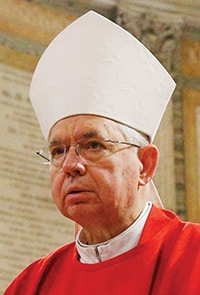 On April 22, Archbishop José H. Gomez, president of the U.S. bishops’ conference and Archbishop of Los Angeles, invited all U.S. bishops to join him on May 1 in reconsecrating the U.S. to the Blessed Virgin Mary in response to the pandemic. The consecration, which was set for May 1 at 3 p.m. EDT, was to be to “Mary, Mother of the Church,” a title given to the Blessed Mother by Pope St. Paul VI at the Second Vatican Council. “Every year, the Church seeks the special intercession of the Mother of God during the month of May. This year, we seek the assistance of Our Lady all the more earnestly as we face together the effects of the global pandemic,” Archbishop Gomez said in a letter sent to all U.S. bishops. “This will give the Church the occasion to pray for Our Lady’s continued protection of the vulnerable, healing of the unwell, and wisdom for those who work to cure this terrible virus.” The reconsecration was timed to coincide with the bishops of Canada, who consecrated their own country to Mary at the same time. |
During the 11th century, the prayer known as the Memorare was composed in Latin from earlier Eastern sources. Some scholars, though, believe it only reached its present form in the 15th century. This prayer manifests supreme confidence in the intercessory assistance of the Virgin Mary. The prayer reads as follows:
“Remember, O most gracious Virgin Mary, that never was it known that anyone who fled to thy protections, implored thy help or sought thy intercession, was left unaided. Inspired by this confidence, I fly unto thee, O Virgin of virgins, my Mother; to thee do I come, before thee I stand, sinful and sorrowful. O Mother of the Word Incarnate, despise not my petitions, but in thy mercy hear and answer me. Amen.”
Perhaps the most well-known prayer of appeal to Mary is the Salve Regina, or Hail Holy Queen. This hymn has been attributed to St. Bernard of Clairvaux (1090-1153), but scholars today believe it was more likely written by either Hermann the Lame (1013-1054), who was a monk of Reichenau, Germany, or Adhemar, Bishop of Le Puy, France (d. 1098). The prayer reads:
“Hail, holy Queen, Mother of mercy, our life, our sweetness and our hope. To thee do we cry, poor banished children of Eve. To thee do we send up our sighs, mourning and weeping in this valley of tears. Turn, then, most gracious advocate, thine eyes of mercy toward us, and after this, our exile, show unto us the blessed fruit of thy womb, Jesus. O clement, O loving, O sweet Virgin Mary.”
This hymn appeals to Mary as “Mother of Mercy,” and it asks her to turn her “eyes of mercy toward us.” Pope Gregory IX (r. 1227-41) and St. Pope Pius V required the Salve Regina to be chanted or sung after compline of vespers during certain times of the liturgical year. The Salve Regina shows how the Church turns to Mary with mourning and weeping to ask for her help as our Mother of mercy and most gracious advocate.
Robert Fastiggi, Ph.D., is a professor of systematic theology at Sacred Heart Major Seminary in Detroit.
Current appeals to Mary around the world |
|---|
|
Appeals to the Blessed Mother to help end the coronavirus pandemic were made by Catholic bishops outside Rome:
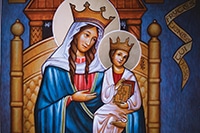
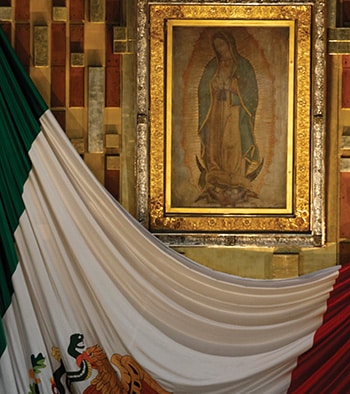
|

